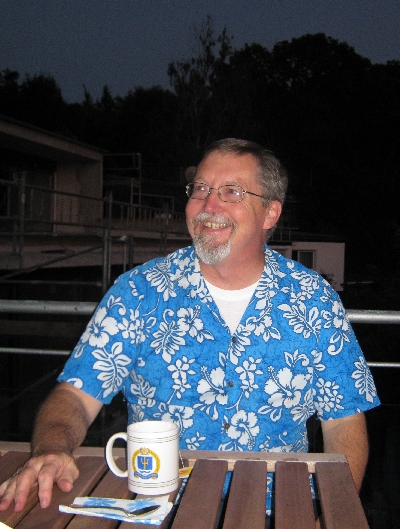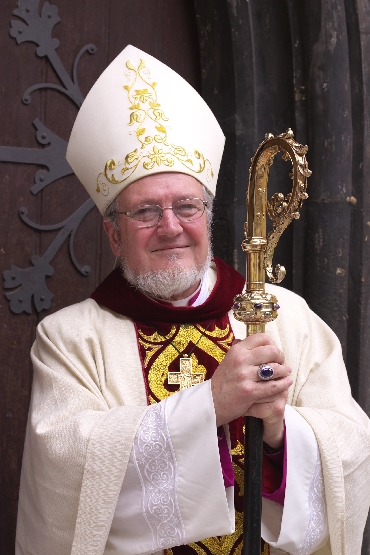
When Bishop Geoffrey Rowell visited the Prague Chaplaincy at the beginning of May this year, he mentioned during a Church Council meeting, about how under the ministry of Rev’d Ken Dimmick, the Anglican Church in Stuttgart had grown both numerically and financially. At a more recent Church Council meeting, some members made reference back to Bishop Geoffrey’s remarks and suggested that it might be good for the Prague Chaplaincy to learn from his experience.
Taking note of what had been said by the Church Council, I wrote to Ken in July, asking if I could visit him in Stuttgart and as suggested, ‘learn from his experience’. His reply was both prompt and positive – he would welcome me to visit though in his very modest way he declared that, “I’m not sure that I have any secret answers to church growth or financial success… Perhaps we were just lucky!”
Last Thursday 19th August, just before 9am, I set out to drive to Stuttgart. It is a journey of just over 300 miles/480 km but, having reached the outskirts of Prague; it is then almost entirely on Czech motorway or German autobahn. I broke the journey with a coffee stop near Amberg in northern Bavaria and then had a sandwich lunch at a Rasthof about 20km north of Stuttgart.
I only had problems with the very last part of my journey as my Google map didn’t indicate that I needed to pass through a road tunnel near the centre of Stuttgart and I therefore avoided the tunnel and ended up several streets away from where I was meant to be. Eventually, I found the name of the street I was in and worked out from my downloaded Google map, how to reach the St. Catherine’s Church Parish Centre where I had agreed to meet Ken at 3pm that afternoon. I finally reached my intended destination with ten minutes to spare.
I spent the following twenty-four hours in Ken’s company, both going with him to a few fixed appointments as well as sharing an enjoyable evening meal together in a Stuttgart beer garden. Ken is an American priest, three years younger than me and a bachelor. He took up the Stuttgart appointment just over four years ago, wanting to do something different rather than remaining in parish ministry in Texas.
When Ken took up his post as Anglican Chaplain in Stuttgart, there were about nine people remaining in the congregation and no real money to pay him. So in advance of his arrival, he successfully raised $US 100,000 from friends and supporters in Texas to help fund the first few years of his ‘Mission to Germany’! This enabled him to rent an apartment in the Stuttgart suburbs and have enough to live on whilst he sought to grow the congregation.
In just over four years, the congregation has grown to between 80-90 on a Sunday and they are now able to pay Ken a modest stipend. He still has some of the US money to fall back on if need be – what he refers to as his ‘Texas slush fund’! Whilst the Church building, (which they share with the German Old Catholics), will hold around 120 people, it has no other facility other than a small meeting room added to the side of the Church over twenty years ago. This began to prove increasingly inadequate as the Anglican congregation grew.

In November 2008 St. Catherine’s took a lease on a former bakery which has gradually been renovated and transformed into a parish centre and office. The Parish Centre is located only a few minutes walk from St. Catherine’s Church. Initially, Ken gave up his suburban apartment and lived in a couple of rooms at the rear of the bakery. Just under a year ago, a small flat in the complex above the bakery became vacant. Ken now lives in this small flat allowing the Parish Centre to be increased in size. Instead of living ‘behind the shop’ he now lives ‘above the shop’!
The Parish Centre is used for after service refreshments on Sunday morning together with Sunday School. During the week there are a variety of events including services of Morning and Evening Prayer, Bible Studies and a Mums and Toddlers Group. Ken has his office in the front of the building which in turn, becomes the shop window for the Church, both figuratively and literally! On the Thursday afternoon whilst I was sitting there talking to Ken, three German youths dropped by wanting to know more about the Anglican Church!
However, being located in an old bakery does attract interesting requests. As can be seen in the photo below, there is still sign protruding from the building with the picture of a pretzel on it. More than two years after the bakery closed down, people still call in wanting to buy bread or cakes. Ken’s response is to say to all who enquire that he offers ‘The bread of life’!
More than anything, it was this Parish Centre with Ken being based there, that most impressed me. Whilst Sybille and I live in a very nice flat, it is out in the suburbs and not in the city centre of Prague. And we have nowhere which is a ‘shop window’ for St. Clement’s during the week. In other respects, what Ken has done to build up the Church in Stuttgart both numerically and financially, is very similar to what I have been doing since arriving in Prague nearly two years ago. In that respect, my conversations with Ken were very reassuring.

So is there somewhere in Prague, not too far from St. Clement’s Church, which could become our ‘Parish Centre’ and office? Even better, somewhere with accommodation above where we could live? Am I dreaming or have I caught a vision for what under God, we might possibly be able to do?






